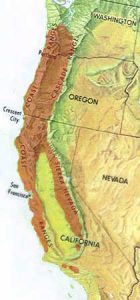Where did Pacifica Iris come from?

Almost all of the nearly 300 recognized wild iris species live in Asia and Europe. Only a few dozen species, all members of a single group, Limniris, beardless irises, reached North America.
The rich spring and summer flora of Washington, Oregon and California includes an attractive array of a dozen wild species in the Iris Series Californicae. Where did these come from? How did they get to the West Coast?
Ancestors of today’s Pacifica irises, like those of the other North American Limniris groups, crossed from Asia into North America during Pleistocene Ice Ages. On repeated occasions, during cold glacial periods (glacial maxima), sea level dropped between the two continents in the northern Pacific Ocean, and was replaced by a broad region of dry land, known as the Bering Land Bridge. Montane and continental ice volume was at maximum size during these glacial maxima.
Under favorable climatic conditions, these Asian irises expanded into their new ranges across North America, east to the Atlantic Ocean, and south into northern Mexico. Today there are many species that live, likeIris setosa, on both sides of the Bering Sea.
Glaciers periodically blanketed much of the northern hemisphere, making huge areas uninhabitable. Remnant iris populations must have been isolated in favorable places for thousands of years, surviving by adapting to local conditions.

During warm interglacial periods (glacial minima), when sea levels rose and continental and montane ice sheets retreated, and climate warmed, some of these formerly isolated populations once again came into contact. But by then, these irises had changed into new forms, and retained their distinctive new appearances and habitat preferences.
This process was repeated over and over again during successive Glacial / Interglacial cycles.
The time spent in isolation was long enough for irises from different areas to look and grow differently, but not to become mutually infertile.
When the ice retreated during interglacial periods, and their ranges again overlapped, many were still able to cross and form hybrids. This is the condition for all the Pacifica species. Pacifica Irises can also sometimes cross with some Siberian irises, although modern“Calsibe” hybrids are almost always infertile.
Taxonomists classify the North American beardless irises into several “series”. Those growing along the Pacific Coast are members of the Californicae series. Their closest relatives appear to be among the Siberian irises (Sibericae series) which live between Japan, China, and the Himalayas in Asia. The Californicae and most of the Siberian species also share the same chromosome number: N = 20.
